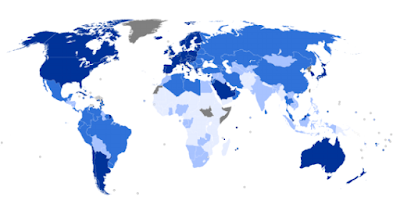Developed or Not? – That is the Question
How can we know if a country is developed? When we
think about developed countries[1], we think about “First World”
countries. However, the term “First World” really refers to the countries that
are considered a part of “the West” as a political bloc. This means the US,
Canada, Australia, Western Europe, Japan, South Korea, Greece and Turkey. “Second
World” refers to the countries that were aligned to the Soviet Bloc. And “Third
World” is, well… all the rest.
Generally speaking, people confuse “First World”
with Developed. Meaning countries that do not belong to the First World (which
is really a political bloc), are not developed. There are really many ways to
measure a country's development. According to the United Nations Statistics
Division: "There is no established convention for the designation
"developed" and "developing" countries or areas in the
United Nations system. And it notes that: The designations
"developed" and "developing" are intended for statistical
convenience and do not necessarily express a judgement about the stage reached
by a particular country or area in the development process".
On a personal level, I consider that countries
that have functioning public healthcare and educational systems are of course,
developed. Let us take a look at the famous Human Development Index (HDI),
which combines an economic measure, national income, with other measures, indexes
for life expectancy and education have become prominent. This criterion would
define developed countries as those with a very high (HDI) rating.
Let us analyse the following graph. We see that
the landscape has changed, compared to the “First, Second and Third World”
division. Most of the countries in the “First World” remain and appear as Very
Highly Developed, except for Turkey. Central Europe also makes the list, with a
strong educational and health system. Saudi Arabia, surprisingly, makes the
list. But what are those two dark blue countries in South America? Could it be
possible? Oh yes, it is, Argentina and Chile are actually considered developed
countries. We can also see that the two least developed countries in South
America: Bolivia and Paraguay, have actually the same levels of developments as
South Africa and India. So if you travel to South America expecting to find
“Indians”, you should probably travel to Bolivia. The rest of the region has
achieved quite good levels of development. Central America though is another
story. Most countries there are quite underdeveloped. Although the worst levels
of developments are, of course, found in Africa.
World map by quartiles of Human Development Index
in 2014:
Very High / High / Medium / Low / Data unavailable
But let us not stay there, let us take a look at
other indicators. The World Bank high-income economy map extends our previous
HDI chart, and includes also countries like Russia and Uruguay.
A high-income economy is defined by the World Bank as
a country with a gross national income per capita above
US$12,735 in 2014. Some high-income countries may also be developing
countries. Thus, a high-income country may be classified as either developed or
developing. A good example could be Venezuela,
that even with a high GPD x capita is not a developed country being an Oil
Nation.
So we see that the map has changed a lot, from
that “First World” economies map. So how could it be that most of the world
population get it so wrong? Very simple, the evil doings of the IMF
(International Monetary Fund). Thought of as an organization to finance or fund
developing nations, the IMF has done nothing for development, and acts as a
gigantic vulture fund. See now that, according to the IMF, the map of advanced
economies has remained unchanged since the fall of the Berlin Wall. Only the
Baltic region and some central European countries are added. This is the mental
picture most people have of today’s world. This is a WRONG picture of the world.
Unless, of course, you are still living in the Cold War.








No comments:
Post a Comment